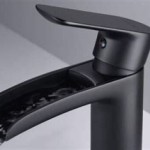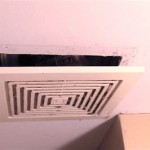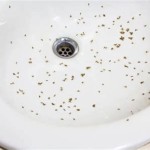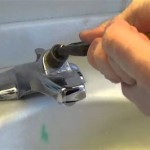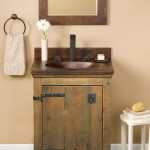How to Stop Sewer Gas Smell in Bathroom Sink
A persistent sewer gas smell emanating from a bathroom sink is a common and unpleasant problem. This odor, often described as rotten eggs, is a clear indication that sewer gases are escaping into the home environment. Identifying the source of the odor and implementing appropriate remedial measures is crucial for maintaining a healthy and comfortable living space. Ignoring this issue can lead to not only olfactory discomfort but also potential health concerns, as exposure to sewer gases, while generally not dangerous in small concentrations, can cause irritation and exacerbate respiratory problems in susceptible individuals. This article provides a comprehensive guide to diagnosing and resolving sewer gas odors originating from a bathroom sink.
The presence of sewer gas in a bathroom signals a breach in the plumbing system's barriers designed to prevent these gases from entering the home. These barriers primarily consist of water-filled traps strategically placed within the drain lines. When these traps fail to maintain a sufficient water seal, sewer gases can readily migrate upwards and into the living space. Addressing this issue promptly and effectively involves a systematic approach to identify the cause and implement the appropriate solution. This often requires a combination of troubleshooting, cleaning, and potentially minor plumbing repairs.
Key Point 1: Understanding the Plumbing System and the Role of the P-Trap
The plumbing system in a bathroom is designed to efficiently remove wastewater while simultaneously preventing sewer gases from entering the living space. A critical component of this system is the P-trap, a U-shaped section of pipe located under the sink. This trap is designed to hold a small amount of water, creating a seal that prevents sewer gases from rising up through the drain and into the bathroom. The effectiveness of the P-trap hinges on maintaining this water seal.
Several factors can compromise the P-trap’s water seal. Evaporation is a common culprit, especially in infrequently used bathrooms. Over time, the water in the trap can simply evaporate, leaving an open pathway for sewer gases. Another possibility is siphonage, which occurs when the draining of water from the sink or a nearby fixture creates a suction force that pulls the water out of the P-trap. This can happen if the plumbing system is not properly vented, allowing negative pressure to build up in the drain lines. Leaks in the drain lines, even small ones, can also disrupt the water seal by allowing water to escape. Finally, blockages in the drain line can create back pressure that forces water out of the trap or allows gases to bypass it.
To effectively troubleshoot a sewer gas smell, a basic understanding of these mechanisms is essential. When investigating a potential P-trap issue, it is important to visually inspect the area beneath the sink for any signs of leaks or damage to the drain pipes. Additionally, consider how frequently the sink is used and whether there have been instances of slow drainage or unusual gurgling sounds coming from the drain, as these symptoms can indicate a potential blockage or venting problem.
Key Point 2: Diagnosing the Source of the Sewer Gas Smell
Pinpointing the exact source of the sewer gas smell is crucial for implementing the correct solution. While the P-trap is the most likely culprit when the odor originates from the bathroom sink, other potential sources should not be overlooked. A systematic approach to diagnosis involves carefully examining the sink, drain, and surrounding plumbing fixtures.
Begin by thoroughly inspecting the P-trap itself. Look for any visible signs of leaks, cracks, or damage to the pipes or fittings. Even a small leak can disrupt the water seal and allow sewer gases to escape. If the P-trap appears to be in good condition, check the drainpipe connections for tightness. Loose connections can create gaps that allow gases to seep through. Next, examine the overflow drain, which is the small hole located near the top of the sink basin. This drain is designed to prevent the sink from overflowing, but it can also become a source of odor if it becomes clogged with debris. Also, ensure that the sink stopper creates a tight seal to prevent gas leaking through here.
If the odor persists after inspecting the sink and drain, consider the possibility of a clogged drain line. A partial blockage can create back pressure that forces water out of the P-trap or allows gases to bypass it. Signs of a clogged drain include slow drainage, gurgling sounds coming from the drain, and water backing up into the sink. In addition to the immediate plumbing fixtures, it is also worthwhile to consider the possibility of issues with the plumbing vent system. Plumbing vents are designed to allow air to enter the drain lines, preventing negative pressure from building up and siphoning water out of the P-traps. If the vent is blocked, it can disrupt the water seals in multiple fixtures throughout the house.
To further isolate the source of the odor, try temporarily sealing the sink drain with a stopper or a piece of duct tape. If the odor disappears, it confirms that the sink drain is the source. If the odor persists, it indicates that the problem lies elsewhere, potentially in the vent system or another fixture in the bathroom. If the smell seems to be coming from the faucet itself, there could be an issue with the water supply line that is allowing gas in. This is rare, but possible.
Key Point 3: Remedial Measures to Eliminate Sewer Gas Odors
Once the source of the sewer gas smell has been identified, the next step is to implement the appropriate remedial measures. The specific solution will depend on the underlying cause of the problem. In many cases, a simple cleaning or minor repair can eliminate the odor. However, more complex issues may require the assistance of a qualified plumber.
If the P-trap has dried out due to infrequent use, simply running water down the drain for a few minutes should restore the water seal and eliminate the odor. If the P-trap is leaking, the affected pipes or fittings may need to be tightened or replaced. Use plumber's tape on the threads of any connections to create a tighter seal. If the overflow drain is clogged, it can be cleaned using a small brush or a pipe cleaner. A mixture of baking soda and vinegar can also be used to flush out the drain. Pour one cup of baking soda down the drain, followed by one cup of vinegar. Let the mixture fizz for about 30 minutes, then flush with hot water.
To address a clogged drain line, several methods can be employed. A plunger can be used to dislodge minor blockages. A drain snake can be used to reach deeper into the drain line and break up or remove stubborn clogs. Chemical drain cleaners should be used with caution, as they can damage the pipes and pose a health risk. A more environmentally friendly alternative is to use a mixture of baking soda, vinegar, and boiling water. Pour one cup of baking soda down the drain, followed by one cup of vinegar. Let the mixture fizz for about 30 minutes, then flush with a pot of boiling water. If the drain remains clogged, it may be necessary to call a plumber to inspect the drain line with a camera and remove any significant obstructions.
If the problem is related to the plumbing vent system, it may be necessary to inspect the vent pipes on the roof for any obstructions, such as leaves, nests, or debris. Clearing these obstructions can restore proper airflow and prevent siphonage. However, working on the roof can be dangerous, so it is advisable to hire a professional plumber to perform this task. In situations where the plumbing vent system is inadequate, a plumber can install additional vents or modify the existing system to improve airflow and prevent sewer gas from entering the home.
If the sewer gas smell persists despite these efforts, it may indicate a more serious problem with the sewer line itself. A cracked or damaged sewer line can allow sewer gases to escape into the surrounding soil and eventually into the home. This type of problem requires professional diagnosis and repair. A plumber can use a camera to inspect the sewer line and identify any cracks, leaks, or other damage. Depending on the severity of the damage, the line may need to be repaired or replaced.
In rare cases, the sewer gas smell may be caused by a defective wax ring on the toilet. The wax ring creates a seal between the toilet and the flange on the floor. If the wax ring is damaged or improperly installed, sewer gases can escape around the base of the toilet. Replacing the wax ring is a relatively simple and inexpensive repair that can often resolve this issue. This only applies if the smell is localized to the toilet, but given the proximity of the toilet to the sink, it always pays to rule it out.
Preventative maintenance can also help to minimize the risk of sewer gas odors in the bathroom. Regularly flushing the drains with hot water can help to prevent the buildup of debris and maintain proper water flow. Avoid pouring grease or other oily substances down the drain, as they can solidify and create clogs. Periodically inspect the P-traps and drain connections for leaks or damage. By taking these precautions, it is possible to keep bathroom plumbing system functioning efficiently and prevent the escape of unpleasant sewer odors.

How To Clean A Stinky Sink Drain Home Repair Tutor

How To Eliminate Basement Odor And Sewer Smells Family Handyman

Sewer Smell In Bathroom Solved Bob Vila

Sewer Smell Archives City Wide Plumbing

How To Get Rid Of The Sewer Smell From A Bathroom Terry S Plumbing

Sewer Smell In Bathroom Identify And Eliminate The Odor

Finding And Curing Plumbing Odors Fine Homebuilding

7 Causes Of A Sewer Smell In The Bathroom Hays

Smell Sewer Gas Don T Call A Plumber Easy Fix

When Ever It Rains Alot Iget A Sewer Gas Smell In One Of My Two Bathrooms The Will Last For 15 To 20 Minutes And
Related Posts


